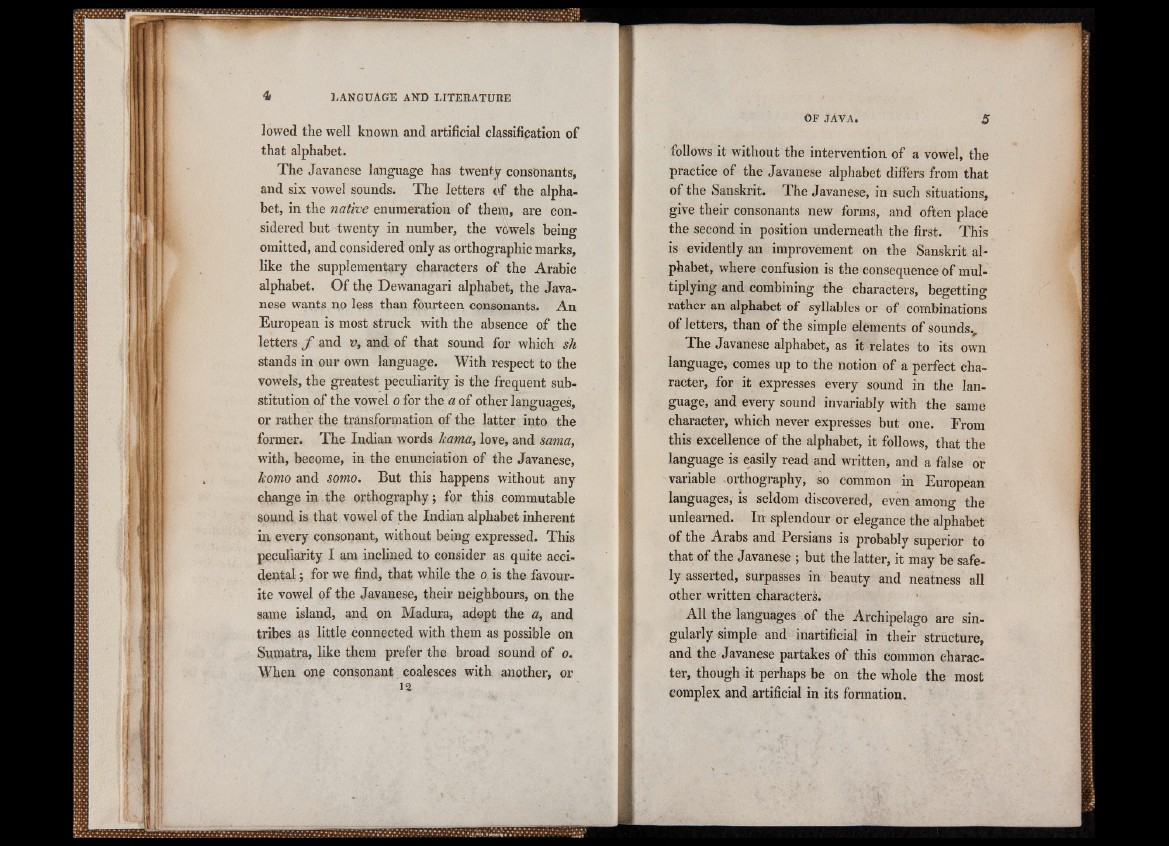
4 LANGUAGE AND LITERATURE
lowed the well known and artificial classification of
that alphabet.
The Javanese language has twenty consonants,
and six vowel sounds. The letters # the alphabet,
in the native enumeration of them, are considered
but twenty in number, the vowels being
omitted, and considered only as orthographic marks,
like the supplementary characters of the Arabic
alphabet. Of the Dewanagari alphabet, the Javanese
wants no less than fourteen consonants. An
European is most struck with the absence of the
letters f and v, and of that sound for which sk
stands in our own language. With respect to the
vowels, the greatest peculiarity is the frequent substitution
of the vowel o for the a of other lanosu aoO’ es,' or rather the transformation of the latter into the
former. The Indian words kama, love, and sama,
with, become, in the enunciation of the Javanese,
homo and somo. But this happens without any
change in the orthography; for this commutable
sound is that vowel of the Indian alphabet inherent
in every consonant, without being expressed. This
peculiarity I ana inclined to consider as quite accidental
; for we find, that while the o is the favourite
vowel of the Javanese, their neighbours, on the
same island, and on Madura, adopt the a, and
tribes as little connected with them as possible on
Sumatra, like them prefer the broad sound of o.
When one consonant coalesces with another, or
ML
follows it without the intervention of a vowel, the
practice of the Javanese alphabet differs from that
of the Sanskrit. The Javanese, in such situations,
give their consonants new forms, and often place
the second in position underneath the first. This
is evidently an improvement on the Sanskrit alphabet,
where confusion is the consequence of mul-
tiplying and combining the characters, begetting
rather an alphabet of syllables or of combinations
of letters, than of the simple elements of soundsv
The Javanese alphabet, as it relates to its own
language, comes up to the notion of a perfect character,
for it expresses every sound in the language,
and every sound invariably with the same
character, which never expresses but one. From
this excellence of the alphabet, it follows, that the
language is easily read and written, and a false or
variable orthography, so common in European
languages, is seldom discovered, even among the
unlearned. In splendour or elegance the alphabet
of the Arabs and Persians is probably superior to
that of the Javanese ; but the latter, it may be safely
asserted, surpasses in beauty and neatness all
other written characters.
All the languages of the Archipelago are singularly
simple and inartificial in their structure,
and the Javanese partakes of this common character,
though it perhaps be on the whole the most
complex and artificial in its formation.